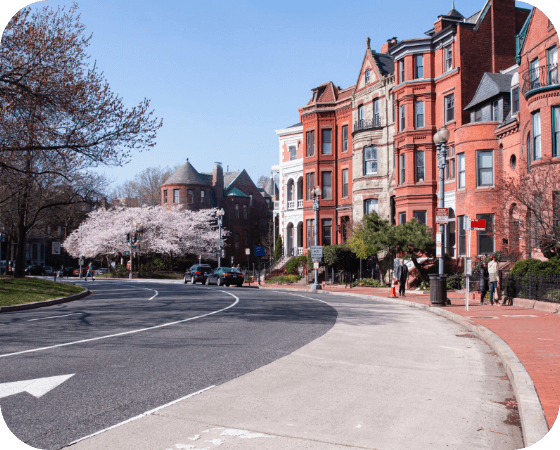A group of West Virginians had something to say to Sen. Joe Manchin (D-WV) about the $3.5 trillion budget reconciliation bill, so they took their message directly to the Senator’s Washington, DC residence – by kayaking up to his houseboat on the Potomac River. When legislators are conducting their business in our nation’s capital, just like anyone else, they need a place to stay. And where members of Congress choose to stay has changed over the years, with potential consequences for how lawmakers do their job.
A Brief History
For much of the 19th century, members of Congress lived in boarding homes in the Capitol Hill neighborhood. Senators and Representatives usually chose which house they lived in based on their political affiliation or state. Known as “messes,” these groupings often included one or two members from a different state or party, allowing lawmakers the chance to build relationships across state or party lines.
As the US entered the 20th century, a growing federal government required members of Congress to be present more regularly in Washington. Soon, it became the norm for legislators to have their homes and their families in the Washington, DC area. By living in the same metropolitan area for most of the year, Representatives and Senators hailing from different political affiliations naturally found ways to form connections outside of legislative business through activities and institutions like schools, playgrounds, sporting events, and places of worship.
1995 marked a major turning point, when then-Speaker Newt Gingrich (R-GA) reduced the workweek in the House from five to three days in order to allow more days for members of his caucus to engage in fundraising. As Congress entered the new millennium, it became increasingly rare for members to spend their time outside of the halls of Congress in DC. Instead, many lawmakers now head right to the airport or hit the road once the workweek ends or recess begins to make the journey back to their home states or districts, where they meet with constituents and fend off potential challengers.
With so many legislators going back and forth, what kind of places do they call home when they’re in Washington?
- Congressional offices. In recent years, dozens of members including former Speaker Paul Ryan (R-WI) and former House Majority Leader Dick Armey (R-TX) have opted to live rent-free in their offices, opting to sleep on sofas or foldable mattresses. While supporters say office living allows them to focus on their work and ignore the distractions of Washington, DC, detractors say the practice unfairly uses taxpayer-funded housekeeping services. Members who live in their offices are most likely to travel frequently between Washington and their state/district.
- Group homes or apartments. Renting a room in a DC rowhouse or apartment isn’t only popular with staffers – members of Congress do it, too. Similar to congressional offices, apartments are popular with members who travel routinely to and from Washington. Echoing back to the days where lawmakers lived in boarding homes, some members opt for a group-home style set-up. A notable example of this is Senate Majority Leader Chuck Schumer (D-NY), Sen. Dick Durbin (D-IL), and former Rep. George Miller (D-CA), who shared a Capitol Hill rowhome until 2014.
- Property ownership in the DC area. A smaller portion of Senators and Representatives reside on property they own in the Washington, DC area. This can range from condominiums or rowhomes in the District to single family homes in the suburban communities of Maryland and northern Virginia. Members in this category generally do not travel as frequently to their home district or state as their fellow legislators, and some even raise their families in the DC area. Examples of current lawmakers who relocated their families to the DC area following their election to Congress include Sen. Josh Hawley (R-MO) and Rep. Jodey Arrington (R-TX). A notable exception within this group is lawmakers from Maryland, Virginia, and other jurisdictions in the Mid-Atlantic who already reside withing commuting distance of Washington.
There are several factors that determine where members of Congress choose to live – and how often they travel to and from Washington.
- Cost of living. Real estate costs have soared in the Washington, DC area over the past decade, with the median price of a rowhouse in the District climbing from $420,000 in 2009 to $760,000 in 2020.
- Competitiveness of seat. Members who expect to face serious primary or general challenges from an opponent are incentivized to return more frequently to their home district or state to campaign or fundraise. Due to frequent travel, they are more likely to keep their housing footprint in the District limited. In contrast, members who hold a “safe” seat might opt to spend more time and put down roots in the District.
- Personal preference. Some members, regardless of their geographic proximity to Washington, choose to bring their families to the Washington, DC area to “keep them grounded” and maintain relationships with children and spouses. These members more likely own property and spend more time in the National Capitol Region.
Why does a member’s housing situation matter? The growing polarization in Congress over the last 20-plus years has coincided with the trend of members not putting down roots in the Washington, DC area. When Representatives and Senators are constantly jetting out of DC, it limits the chances for them to bond, socialize, and see one another as peers. If more members spent more time living in the DC area, could this shift the current political climate and contribute more to bipartisanship?

